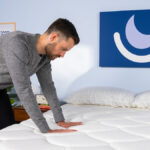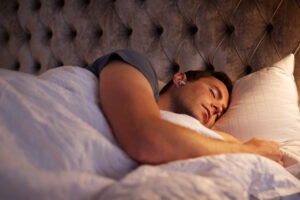At a Glance:
- 40% of surveyed adults have admitted to trying social media sleep trends.
- Those between the ages of 25 and 44 are the most likely to have tried a viral sleep trend.
- Some of these viral sleep trends are not healthy — and in select cases, they can even be dangerous.
- Many folks are fascinated by these viral practices and take to TikTok to learn more, with the hashtags #bedrotting racking up 178 million views and #mouthtaping bringing in 373 million views.
It’s not unusual for Jill Haynes, 43, to spend an entire day in her pajamas in bed, phone in hand, leaving only to get up to use the bathroom and get food.
A middle school teacher in St. Joseph, Missouri, Haynes regularly stays in bed for extended periods of time, a routine the full-time working mom says originated for her during the early stages of the COVID pandemic.
“I worked through the whole pandemic with the public and was constantly on edge,” she says. “I started to notice my mental and emotional state deteriorating, and by the weekend, I would be physically unable to leave my bed.”
The practice, now known as “bed rotting,” thanks to the viral self-care trend sweeping TikTok, involves being in bed for lengthy periods of time to do anything but sleep. For Haynes, who has continued hunkering down in bed (usually on Saturdays) over the course of the past three years, it involves podcasts, audio books, television, snacks (specifically sour gummy worms) — and, of course, all the cozy blankets and pillows.
“I listen to what my body needs and give myself the grace to decompress,” Haynes shares. “If some weeks are very social, like parent-teacher conference weeks, I may take all weekend. If I’m tired, I nap. If I’m in pain or just not wanting to see people, I don’t.”
She adds that spending this time in bed has no effect on her ability to fall asleep at night: “Strangely enough, I know I made the right choice because I am still able to go to sleep at 10 p.m. after being in bed all day. I literally could not go back to work on Monday and be functional if I didn’t take this time to rest.”
Mental health-boosting aside, what other impacts can bed rotting have? Is the occasional bed rotting session really okay? Dr. Michael J. Breus, a psychologist who is board-certified in sleep medicine and is a Fellow of the American Academy of Sleep Medicine, says it’s “not a great idea.”
“Bed was really only made for two things – sleep and sex. You should really only be in bed for the period of time in which you’re sleeping. When people are lying in bed for extended periods of time, their brain doesn’t know what it’s supposed to do. Is it supposed to be awake? Is it supposed to be asleep? If you’re getting micro-sleeps or patches of sleep here and there, it’s not consolidating your sleep time.”
Basically, it all ties into having good sleep hygiene, or arranging your bedroom and your personal habits to set yourself up for a good night’s sleep. The more time you spend bed rotting or doing other activities in bed, the harder it can be for you to fall asleep when you need to be sleeping.
Dr. Breus adds that the optimal amount of time to be in bed is somewhere between 7-9 hours, which is the recommended daily amount of sleep for an average adult.
When Sleep Trends Go Viral
Bed rotting is just one of several sleep trends sweeping social media, and more than a few folks have put them into practice. According to a 2023 survey by the American Academy of Sleep Medicine (AASM), nearly 40% of Americans have tried these social media sleep trends, ranging from livestreaming their sleep (known as sleepfluencing) to mouth taping to sleeping in 90-minute increments. Those between the ages of 25 and 44 — millennials and young Gen Xers — are the most likely to have tried a viral sleep trend.
As for why people might turn to the likes of Instagram and TikTok to solve their sleep problems, Dr. Breus chalks it up to finding easy answers.
“They all have either sleep questions or problems and are just looking for convenient answers,” he says. “Most people can only access a sleep specialist if they already think they have a sleep disorder. There are very few general knowledge places for them to get information about sleep.”
When people rely too heavily on Dr. Google for medical advice rather than seeking the expert guidance of licensed professionals, the outcome may not have a desired result. In some cases, it can even be harmful if they’re self-treating for an issue that’s undiagnosed.
When people decide to document these practices for the masses, their popularity spreads. A self-proclaimed bed rotter may post a video or selfie of themselves surrounded by layers of blankets, book or snack in hand. Mouth taping is another trend that involves taping your mouth shut at night in order to potentially sleep better. The popular hashtag #mouthtaping currently has 373 million views on TikTok.
Mischelle Storm, 44, first learned about mouth taping in the book Breath: The New Science of a Lost Art by James Nestor. She was instantly intrigued by the idea and hoped the practice might lead to a better night’s rest.
“I’m all for alternative wellness practices and was curious to see if mouth taping would help improve my sleep,” she shares. “I personally suffered from restless sleep and sometimes would wake up in a puddle of my own drool which led me to believe I must be sleeping with my mouth open. After reading the book, I figured this was an easy fix and worth a try.”
According to the book’s author, taping your mouth shut while sleeping trains the tissues inside the nasal cavity and throat to flex and stay open, which can offer potential benefits such as a deeper sleep, improved dental health, and reduced snoring.
Storm, a stay-at-home mom in Jacksonville, Florida, started by using medical tape, but it made her “break out around the mouth,” and she’s since purchased actual mouth-taping strips (yes, they are a real thing, and they’re made of everything from fabric to medical tape) in the hopes it will improve sleep.
“Probably the longest stretch of time I did was two weeks,” Storm notes, adding that she intends to continue the process. “I don’t think it was enough time to see a huge difference, but I do feel like I slept better despite having my mouth taped shut all night long.”
She isn’t alone in hoping that a closed mouth will result in better shut-eye. As many as 12% of Americans have tried mouth taping, according to the AASM survey on social media trends. Dr. Breus’ take? “Mouth taping can be helpful for people who only snore, and you need to have been screened for sleep apnea before trying it, or it could be dangerous.”
When searching for scientifically-backed solutions for getting a good night’s sleep, it’s easy to resort to doomscrolling for weighted stuffed animals and sleep plants, but there are also a few proven strategies that actually work. Dr. Breus says that key among them are keeping a consistent sleep schedule, monitoring caffeine intake, avoiding alcohol around bedtime, and exercising daily.
And you don’t need your phone for that.
References (1)
AASM Sleep Prioritization Survey: Social Media Trends (2023). American Academy of Sleep Medicine., Retrieved August 10, 2023, from https://aasm.org/wp-content/uploads/2023/07/sleep-prioritization-survey-2023-social-media-trends.pdf
Ask the Sleep Doctor
Have questions about sleep? Submit them here! We use your questions to help us decide topics for articles, videos, and newsletters. We try to answer as many questions as possible. You can also send us an email. Please note, we cannot provide specific medical advice, and always recommend you contact your doctor for any medical matters.

